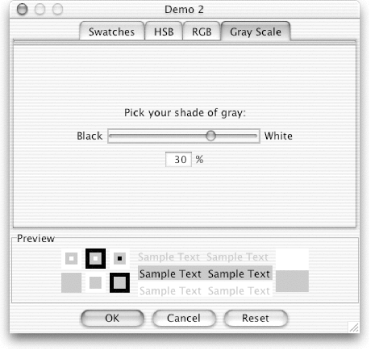12.5 Developing a Custom Chooser Panel
If you look at the JColorChooser component,
you'll realize that it is really just a tabbed pane
with a color previewer below it. You can have as many chooser panels
in it as you like. Let's take a brief look at a
panel that can be added to a color chooser. We'll
create a simple panel for selecting a shade of gray with one slider
rather than pushing each slider for red, green, and blue to the same
value. Figure 12-8 shows the resulting panel; its
source code is presented here.
// GrayScalePanel.java
// A simple implementation of the AbstractColorChooserPanel class. This class
// provides a slider and a text field for picking out a shade of gray.
//
import java.awt.*;
import java.awt.event.*;
import javax.swing.*;
import javax.swing.event.*;
import javax.swing.colorchooser.*;
public class GrayScalePanel extends AbstractColorChooserPanel
implements ChangeListener, ActionListener {
JSlider scale;
JTextField percentField;
// Set up our list of grays. We'll assume we have all 256 possible shades,
// and we'll do it when the class is loaded.
static Color[] grays = new Color[256];
static {
for (int i=0; i<256; i++) { grays[i] = new Color(i, i, i); }
}
public GrayScalePanel( ) {
setLayout(new GridLayout(0, 1));
// Create the slider and attach us as a listener.
scale = new JSlider(JSlider.HORIZONTAL, 0, 255, 128);
scale.addChangeListener(this);
// Set up our display for the chooser.
add(new JLabel("Pick your shade of gray:", JLabel.CENTER));
JPanel jp = new JPanel( );
jp.add(new JLabel("Black"));
jp.add(scale);
jp.add(new JLabel("White"));
add(jp);
JPanel jp2 = new JPanel( );
percentField = new JTextField(3);
percentField.setHorizontalAlignment(SwingConstants.RIGHT);
percentField.addActionListener(this);
jp2.add(percentField);
jp2.add(new JLabel("%"));
add(jp2);
}
// We did this work in the constructor, so we can skip it here.
protected void buildChooser( ) { }
// Make sure the slider is in sync with the other panels.
public void updateChooser( ) {
Color c = getColorSelectionModel( ).getSelectedColor( );
scale.setValue(toGray(c));
}
protected int toGray(Color c) {
int r = c.getRed( );
int g = c.getGreen( );
int b = c.getBlue( );
// Grab the luminance the same way GIMP does.
return (int)Math.round(0.3 * r + 0.59 * g + 0.11 * b );
}
// Pick a name for our tab in the chooser.
public String getDisplayName( ) { return "Gray Scale"; }
// No need for an icon
public Icon getSmallDisplayIcon( ) { return null; }
public Icon getLargeDisplayIcon( ) { return null; }
// Finally, update the selection model as our slider changes.
public void stateChanged(ChangeEvent ce) {
getColorSelectionModel( ).setSelectedColor(grays[scale.getValue( )]);
percentField.setText("" + (100-(int)Math.round(scale.getValue( ) / 2.55)));
}
public void actionPerformed(ActionEvent ae) {
int val = 100 - Integer.parseInt(ae.getActionCommand( ));
getColorSelectionModel( ).setSelectedColor(grays[(int)(val * 2.55)]);
}
}

Here's the application that produced the new
chooser. The only real change is that we manually build the list of
chooser panels for our chooser in the ColorPicker2
constructor:
// ColorPicker2.java
// A quick test of the JColorChooser dialog
//
import java.awt.*;
import java.awt.event.*;
import javax.swing.*;
import javax.swing.colorchooser.*;
public class ColorPicker2 extends JFrame {
JFrame parent;
Color c;
public ColorPicker2( ) {
super("JColorChooser Test Frame");
setSize(200, 100);
parent=this;
final JButton go = new JButton("Show JColorChoser");
final Container contentPane = getContentPane( );
go.addActionListener(new ActionListener( ) {
final JColorChooser chooser = new JColorChooser( );
boolean first = true;
public void actionPerformed(ActionEvent e) {
if (first) {
first = false;
GrayScalePanel gsp = new GrayScalePanel( );
chooser.addChooserPanel(gsp);
}
JDialog dialog = JColorChooser.createDialog(parent, "Demo 2", true,
chooser, new ActionListener( ) {
public void actionPerformed(ActionEvent e) {
c = chooser.getColor( );
}}, null);
dialog.setVisible(true);
contentPane.setBackground(c);
}
});
contentPane.add(go);
setDefaultCloseOperation(EXIT_ON_CLOSE);
}
public static void main(String args[]) {
ColorPicker2 cp2 = new ColorPicker2( );
cp2.setVisible(true);
}
}
|
